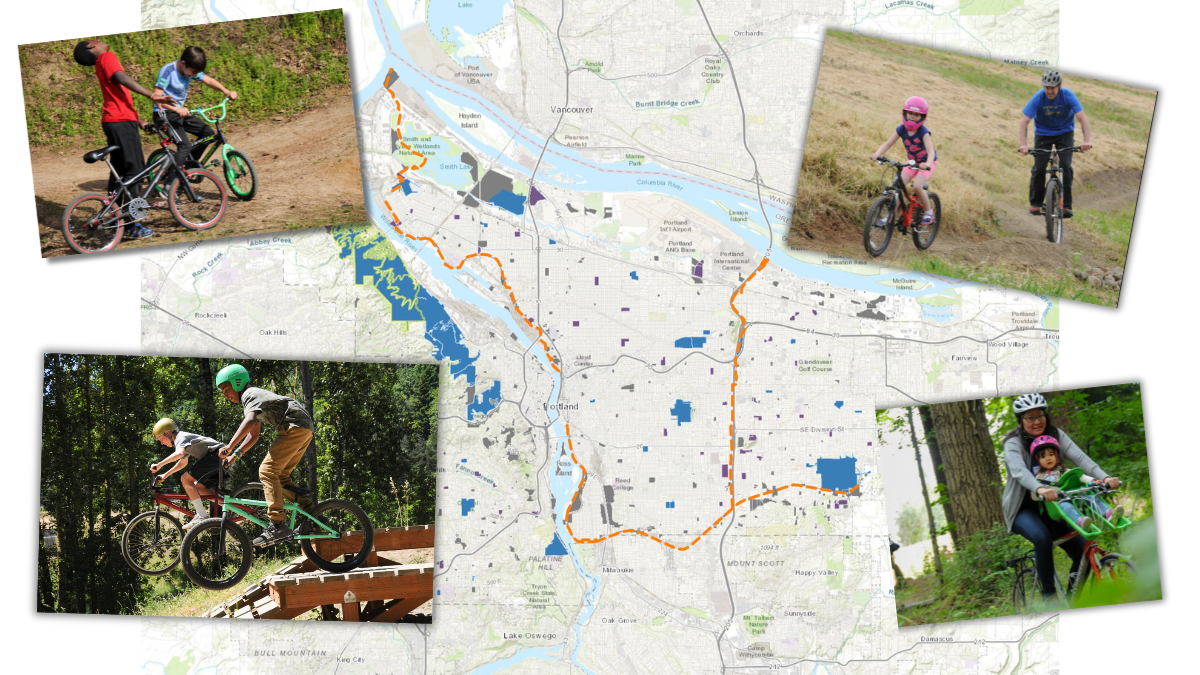
(Map: Bureau of Planning & Sustainability. Photos: Jonathan Maus/BikePortland)
There are 154 parks in Portland with about 12,000 acres of land. About one-forth of those acres have something built on them (think golf course, playgrounds, racetrack at PIR, and so on) and the rest (about 70% of the total acreage) is just grass and trees and dirt. According to the newly adopted Off Road Cycling Master Plan, 23 of those parks could easily handle new bike trails or some sort of pump/skills track.
For years now, some folks have felt like we could build more off-road trails in these parks in order to open up more cycling opportunities for Portlanders. Right now there’s a shocking lack of places in this city where you can hop on a bicycle and experience the mental and physical pleasures of navigating a dirt trail. The people who love doing that are mostly forced to hop in their cars and head to riding areas near Mt. Hood, Sandy, Hood River, or (relatively recently) Scappoose. For everyone else, off-road cycling has just never been an option.
Yes, we have dirt to ride in Forest Park, but it’s either extremely boring (flat, wide roads) or extremely difficult for all but expert riders.
The solution, some people say, is to use what we have and build new trails and riding areas inside the existing parks that are within an easy bicycling distance of almost every Portlander. We’ve already had some success with this: the Gateway Green bike park and the small pump tracks at Ventura Park (also east Portland) and in New Columbia neighborhood in St. Johns. On any given day when the sun is out and dirt is dry, you can find all types of smiling people — especially younger ones — riding bikes in these parks.
Why do we have so few places like this? Part of the reason is politics and what I’ve described as Portland’s irrational fear of off-road cycling. But it’s also just due to a lack of planning and advocacy. Before anything happens around here, we need some sort of plan. Then we need people who care about it to stand up and push for it. When it comes to off-road cycling in parks, we now have both parts of that equation primed and ready-to-go.
Now that the Off Road Cycling Master Plan is an official city plan, it’s time to recognize that its authors have singled out 23 existing city parks — in every corner of our city — they think are compatible with unpaved bike riding areas. The list below comes from a map included in the plan where BPS labels parks and other parcels that are ripe for new trails and/or bike parks. Check it out, and get those gears turning for more places to safely ride our bikes without having to drive a car to a trailhead!
North
Pier Park – 85 acres
- A Master Plan, developed with community involvement, to guide future improvements to the park
- A medium-sized bicycle park (about 1 acre). Bicycle parks have areas for family recreation and skill building. The bicycle park could be located near the popular skate park.
- A natural surface loop trail for family-friendly cycling, walking, running and enjoyment of nature. Off-road cycling skill features (like rocks, logs, or skinny bridges) could be added along the sides. Care should be taken to limit potential conflicts with disc golf course.
University Park – 11 acres
- A small bicycle park (about 5,000 to 10,000 ft²). Bicycle parks have areas for family recreation and skill building. The bicycle park would be located outside the sports fields.
- A natural surface loop trail for family-friendly cycling, walking and running. Off-road cycling skill features (like rocks, logs, or skinny bridges) could be added along the sides.
- Building a bicycle park or trail here will require additional planning and community input
Dog Bowl – 25 acres
- Habitat restoration including native plantings and removal of invasive plants
- Closure and restoration of existing demand trails.
- A natural surface trail network for family-friendly cycling, walking, running and enjoyment of nature. This trail network should connect should remain on the upper, flatter portion of the site and protect oak habitat
- Building a trail here will require additional planning and community input
- Transfer of property to Portland Parks & Recreation
Farragut Park – 14 acres
- A small bicycle park (about 5,000 to 10,000 sf). Bicycle parks have areas for family recreation and skill building
- A natural surface loop trail for family-friendly cycling, walking and running
- Building a bicycle park or trail here will require additional planning and community input
Northeast
Fernhill Park – 27 acres
- A natural surface loop trail for family-friendly cycling, walking, running and enjoyment of nature. Off-road cycling skill features (like rocks, logs, or skinny bridges) could be added along the sides. A well-designed loop of approximately 1.5 miles could also provide a better trail for the cross-country running races and training held at the park. Care should be taken to limit potential conflicts with off-leash dog area.
- A medium-sized bicycle park (about 1 acre). Bicycle parks have areas for family recreation and skill building
- A Master Plan, developed with community involvement, to guide future improvements to the park. This Master Plan could also consider an east-west paved and lighted trail to improve park access and connections.
- Building a bicycle park or trail here will require additional planning and community input, including from neighbors, running groups, off leash dog area users, and other park users.
Glenhaven Park – 14 acres
- A natural surface loop trail for family-friendly cycling, walking, running and enjoyment of nature. Off-road cycling skill features (like rocks, logs, or skinny bridges) could be added along the sides. The loop trail could connect to the proposed trail at Rose City Golf Course and connect to neighborhoods south of NE Tillamook Street.
- A small bicycle park (about 5,000 to 10,000 ft²). Bicycle parks have areas for family recreation and skill building.
- Building a bicycle park or trail here will require additional planning and community input.
Rose City Golf Course – 151 acres
- A natural surface loop trail for family-friendly cycling, walking, running and enjoyment of nature. Off-road cycling skill features (like rocks, logs, or skinny bridges) could be added along the sides. The loop trail could provide safe walking access along NE Tillamook and connect neighborhoods to the south of the golf course to Glenhaven Park. Creating a full loop may require on-street segments. Care should be taken to limit potential conflicts with the golf course.
- A small bicycle park (about 5,000 to 10,000 ft²). Bicycle parks have areas for family recreation and skill building.
- Building a bicycle park or trail here will require coordination with the Rose City Golf Course and additional planning and community input.
John Luby Park – 10 acres
- A natural surface loop trail for family-friendly cycling, walking, running and enjoyment of nature. Off-road cycling skill features (like rocks, logs, or skinny bridges) could be added along the sides. The loop trail could provide safe walking access along NE Tillamook and connect neighborhoods to the south of the golf course to Glenhaven Park. Creating a full loop may require on-street segments. Care should be taken to limit potential conflicts with the golf course.
- A small bicycle park (about 5,000 to 10,000 ft²). Bicycle parks have areas for family recreation and skill building.
- Building a bicycle park or trail here will require coordination with the Rose City Golf Course and additional planning and community input.
Southeast
Colonel Summers Park – 6 acres
- A small bicycle park (about 5,000 – 10,000 ft²). Bicycle parks have areas for family recreation and skill building
- Building a bicycle park here will require additional planning and community input
Mt Tabor Park – 183 acres
- Habitat restoration including native plantings and removal of invasive plants
- Closure and restoration of demand trails.
- Trail network improvements to make it more sustainable, reduce redundant trail segments, and create a loop for off-road cycling
- Improved signage to help park users navigate and understand whether trails are open to pedestrians, cyclists, or both
Creston Park – 14 acres
- A small bicycle park (about 5,000 – 10,000 ft²). Bicycle parks have areas for family recreation and skill building. The bicycle park could replace the closed tennis courts.
- A natural surface loop trail for family-friendly cycling, walking, running and enjoyment of nature
- Building a bicycle park or trail here will require additional planning and community input
Brentwood Park – 13 acres
- A small bicycle park (about 5,000 – 10,000 ft²). Bicycle parks have areas for family recreation and skill building
- Building a bicycle park here will require additional planning and community input
Gates Park – 11 acres
- A Master Plan, developed with community involvement, to guide future improvements to the park
- A large bicycle park (1 to 3 acres). Bicycle parks have areas for family recreation and skill building
- A natural surface loop trail (about ½ mile) for family-friendly cycling, walking and running. Off-road cycling skill features (like rocks, logs, or skinny bridges) could be added along the sides.
Lynchview Park – 8 acres
- A small bicycle park (about 5,000 to 10,000 ft²). Bicycle parks have areas for family recreation and skill building
- A natural surface loop trail for family-friendly cycling, walking and running. Off-road cycling skill features (like rocks, logs, or skinny bridges) could be added along the sides.
- Possible partnership with the adjacent elementary school
- Building a bicycle park or trail here will require additional planning and community input
- This location is an alternate to Parklane Park
Ventura Park – 7 acres
Ventura Park has two pump tracks — one for intermediate riders and a second for young children.
- Continuing to improve drainage at the pump track
- Improving and possibly expanding the pump tracks
- A natural surface loop trail for family-friendly cycling, walking and running. Off-road cycling skill features (like rocks, logs, or skinny bridges) could be added along the sides.
South
River View Natural Area – 146 acres
- Stream and habitat restoration including native plantings and removal of invasive plants
- Continued the interim prohibition of off-road cycling until sustainable trails are identified or developed
- Complete detailed alignment planning and trail design for the natural surface trail loop described in the River View Natural Area Management Plan’s Access and Management Concept as a model of a sustainable and safe shared-use trail.
- Design trails using best management practices appropriate to the natural area’s topography, environmental assets, and expected level of use by pedestrians and cyclists. See pages 76 – 77 of the Discussion Draft for additional design guidance.
- If the City cannot identify a sustainable shared-use trail alignment that is consistent with best management practices while meeting site objectives, evaluate alternative approaches and management strategies.
- Fund and build a well-designed, sustainable trail that will limit potential negative impacts, reduce maintenance costs, and serve recreational users. Ongoing investment in trail maintenance will also be required.
- Consider opportunities to build other recommended natural surface trails in western Portland either before, or in concert with, River View trail design and construction to help distribute the latent demand for off-road cycling experiences.
- Develop a maintenance plan for the trail system that identifies unacceptable environmental impacts or safety risks and methods to address these impacts.
- Monitor trail use, including any safety or environmental risks, through on-site observation and/or community reporting.
- Use adaptive management strategies (e.g. seasonal closures, trail improvements, education, conditional or permanent rerouting or closure of trails, use restrictions) to address unsustainable conditions or unacceptable impacts.
- Building a trail here will require additional planning and community input
Loll Wildwood – 2 acres
- A Management Plan for the entire natural area, developed with community involvement, to guide environmental restoration, stewardship, and recreational access
- Stream and habitat restoration including native plantings and removal of invasive plants
- Closure and restoration of existing demand trails
- Natural surface trails for family-friendly cycling, walking, running and enjoyment of nature. Trails could include and east-west trail on the north side of the creek, a single bridge crossing, and a loop trail on the south side of the creek. The trails would provide a way to experience the natural area and make it easier to walk and bike to destinations in the neighborhood.
- Building a trail here will require additional planning and community input
Lesser Park – 8 acres
- Habitat restoration including native plantings and removal of invasive plants
- Closure and restoration of existing demand trails
- A natural surface trail network for family-friendly cycling, walking, running and enjoyment of nature. This trail network should connect to natural trails at the Portland Community College – Sylvania Campus.
- Building a trail here will require additional planning and community input
Southwest
Gabriel Park – 90 acres
- A Master Plan, developed with community involvement, to guide future improvements to the park
- Continued natural area enhancements. Gabriel Park’s natural areas have undergone significant environmental restoration and pedestrian trail improvements
- A medium-sized bicycle park (about 10,000 ft² to ½ acre). Bicycle parks have areas for family recreation and skill building. The bicycle park could be located near the popular skate park and away from natural areas.
- A shared-use natural surface loop trail (about 1.5 to 3 miles), outside of the core natural area. This trail could be used by nearby residents for family-friendly cycling, walking, running and enjoyment of nature. Off-road cycling skill features (like rocks, logs, or skinny bridges) could be added along the sides.
- A designated safe pedestrian and cyclist route along SW 45th Avenue, including crossings
- Improved signage to help park users navigate and understand whether trails are open to pedestrians, cyclists, or both
Hamilton Park – 10 acres
- A small bicycle park (about 5,000 to 10,000 ft²). Bicycle parks have areas for family recreation and skill building
- A natural surface loop trail for family-friendly cycling, walking, running and enjoyment of nature
- Building a bicycle park or trail here will require additional planning and community input
Washington Park – 292 acres
- Restoration of degraded wildlife habitat through native plantings and removal of invasive plants
- Closure and restoration of existing demand trails
- A natural surface off-road cycling trail loop in the area east of Kingston Drive, as envisioned in the Draft Washington Park Master Plan. Trails could include a descending flow trail and an uphill skill trail.
- Building a trail here will require additional planning and community input
Forest Park (Southern Section) – 1178 acres
- Continue to implement the Forest Park Natural Resource Management Plan and other adopted plans and strategies for the park
- Expand and enhance a comprehensive education and outreach program regarding trail rules and etiquette
- Improve signage for wayfinding and trail use expectations
- Increase resources and partnerships for restoration, management, enforcement and trail maintenance
- Monitor impacts of trails and recreation use on vegetation, wildlife and users
- Practice adaptive management, including trail closures, to address unintended negative impacts. Decommission unsanctioned trails
- Improve Firelane 1 for better environmental sustainability and to make it a safer and more enjoyable route for cycling, walking, and running, while maintaining emergency access
- Build a new trail open to off-road cyclists parallel to St. Helen’s Road. This trail should connect Northwest Portland to the proposed Forest Park Nature Center and Firelane 1
- Build a new trail south of NW 53rd Drive (conditional on completion of Firelane 1 improvements, St. Helen’s trail, improvements to Holman Lane, and assessment of watershed impacts)
- See pages 61 – 72 of theDiscussion Draft for more information
Forest Park (Central Section) – 1945 acres
- Continue to implement the Forest Park Natural Resource Management Plan and other adopted plans and strategies for the park
- Expand and enhance a comprehensive education and outreach program regarding trail rules and etiquette
- Improve signage for wayfinding and trail use expectations
- Increase resources and partnerships for restoration, management, enforcement and trail maintenance
- Monitor impacts of trails and recreation use on vegetation, wildlife and users
- Practice adaptive management, including trail closures, to address unintended negative impacts. Decommission unsanctioned trails
- Improve Firelane 1 for better environmental sustainability and to make it a safer and more enjoyable route for cycling, walking, and running, while maintaining emergency access
- Build a new trail open to off-road cyclists parallel to St. Helen’s Road. This trail should connect Northwest Portland to the proposed Forest Park Nature Center and Firelane 1
- Build a new trail south of NW 53rd Drive (conditional on completion of Firelane 1 improvements, St. Helen’s trail, improvements to Holman Lane, and assessment of watershed impacts)
- See pages 61 – 72 of the Discussion Draft for more information
Check out the Off Road Cycling Plan website where you’ll find the map and lots of other helpful info.


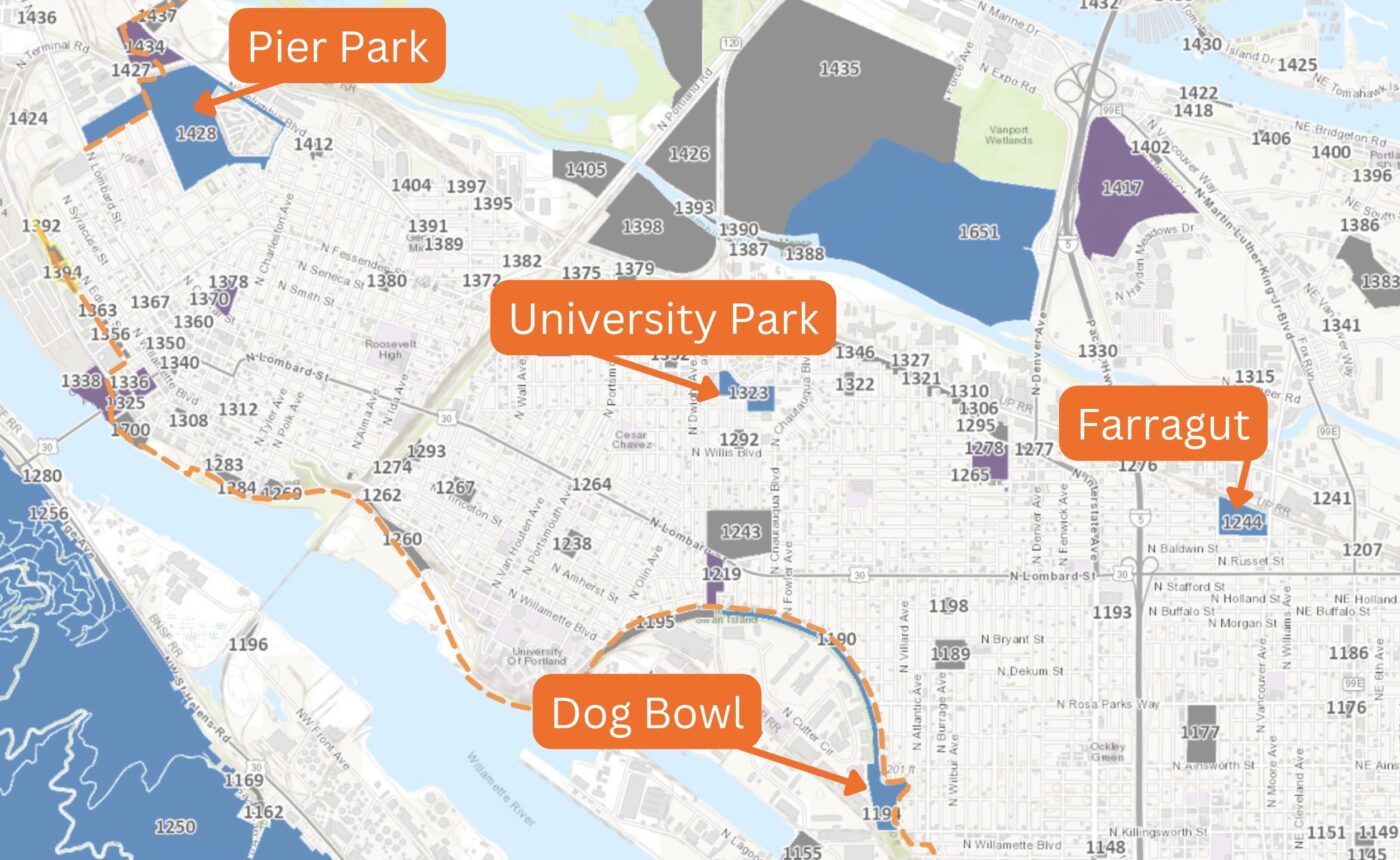
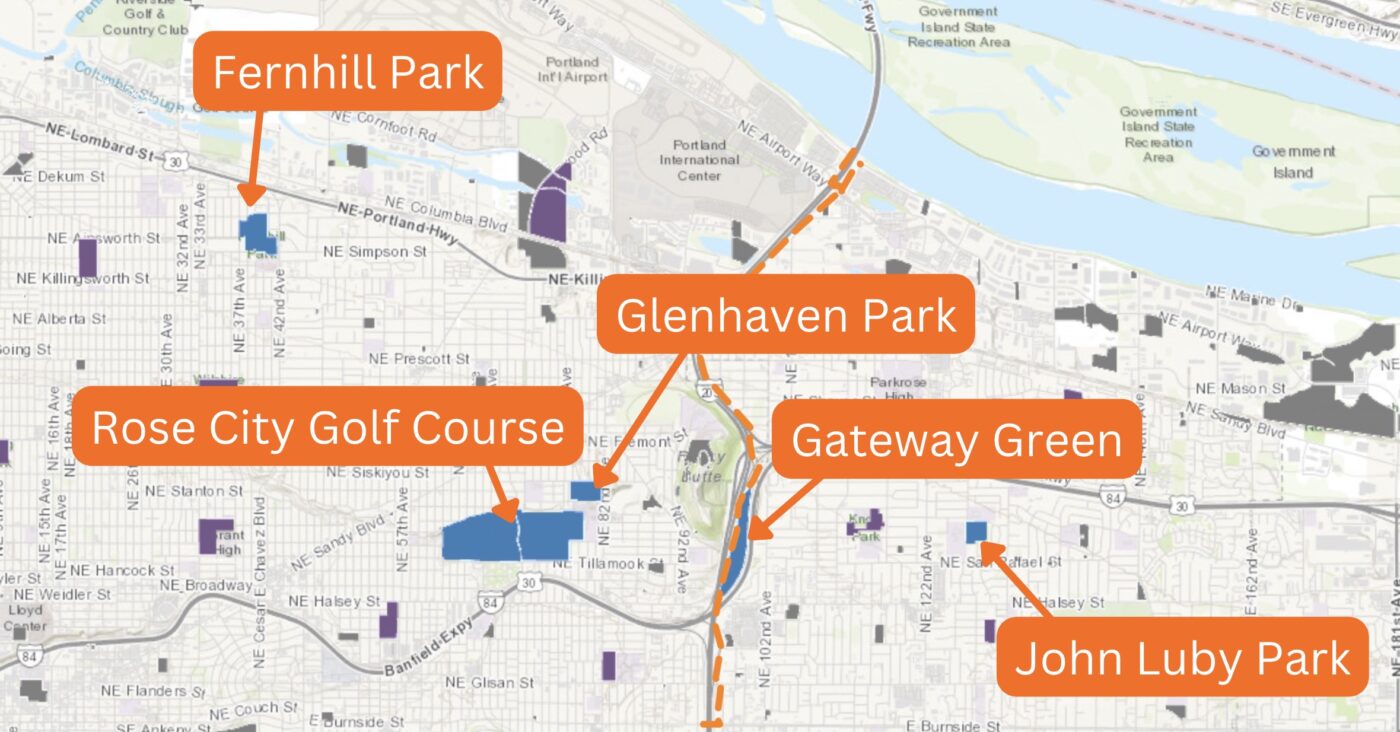

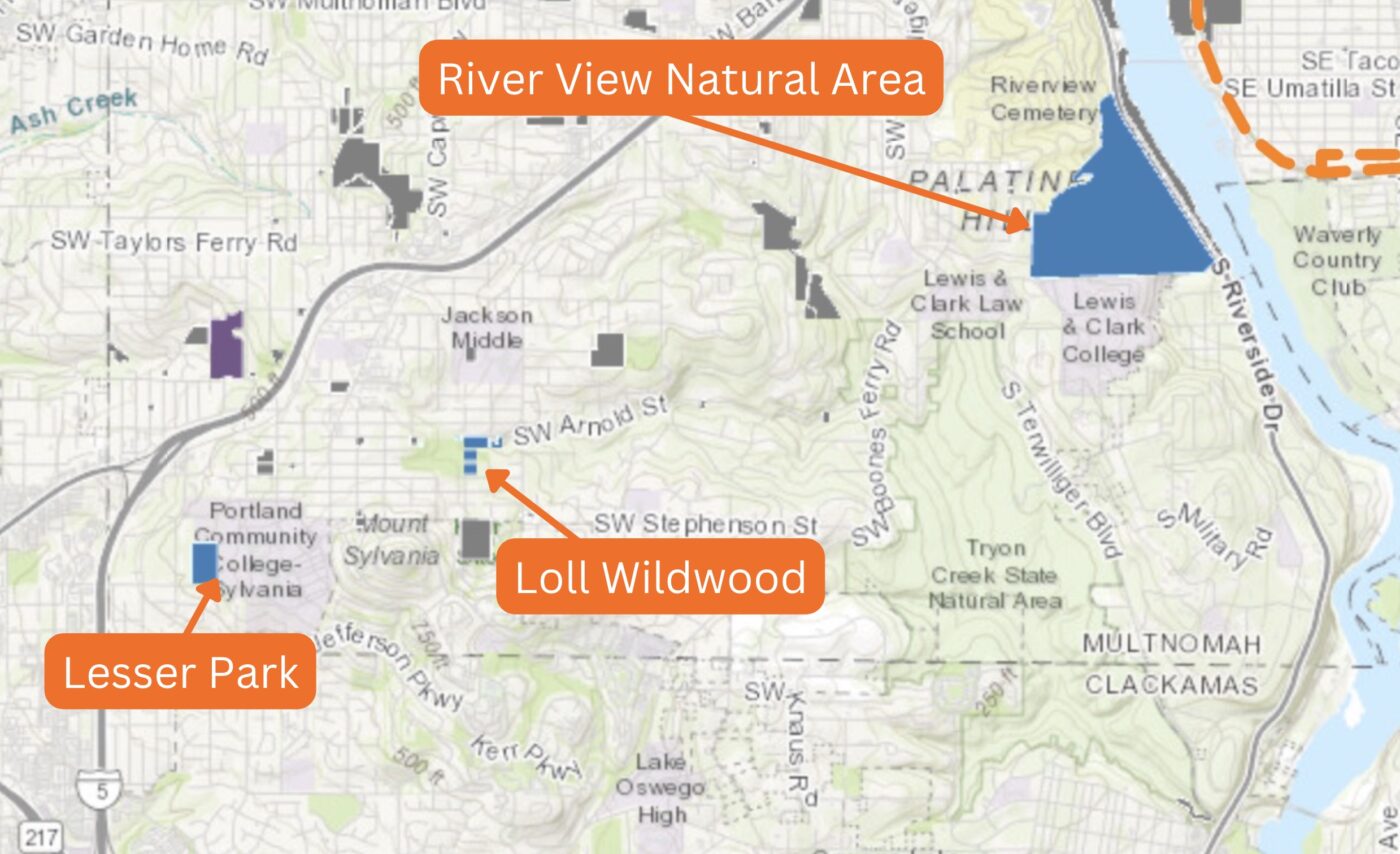

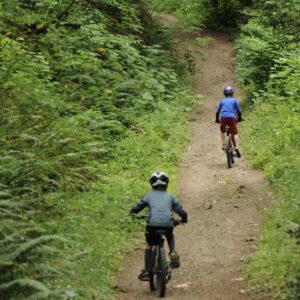
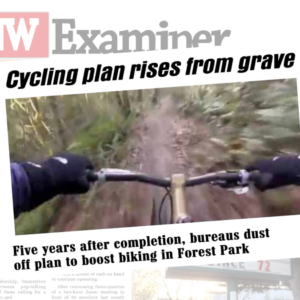
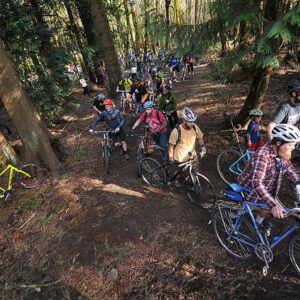

Thanks for reading.
BikePortland has served this community with independent community journalism since 2005. We rely on subscriptions from readers like you to survive. Your financial support is vital in keeping this valuable resource alive and well.
Please subscribe today to strengthen and expand our work.
Very excited for more local dirt to ride!
Anyone that wants to get involved with advocacy, or learn/practice sustainable trail building, the North West Trail Association is a great local resource that’s always looking for volunteers for dig days, I would be shocked if they do not have a big hand in helping develop these new opportunities. Trail work event info can be found at https://nw-trail.org/volunteer/trailwork/
New to trail building or think that you won’t know what to do? I absolutely recommend joining the free classes NWTA offers, very informative and aimed at learning. From personal experience these classes are very welcoming and super helpful, even for those who know their way around a rogue hoe and shovel. Info for the Trails Sustainability Institute at https://nw-trail.org/volunteer/learn/
Good news. Now cue the NIMBY bike haters for EVERY park. Fingers crossed NWTA and the community can outlast the hyperbole coming at each of the park plans.
Does this need to be done at these parks? “existing demand” trails exist because… there is demand for travel along that route? Why not just legalize the trails that already exist?
As I understand they would need to be assessed on a case by case basis, some demand trails may be fine and become sanctioned while some can be unsustainable or unsafe due to erosion and/or poor drainage.
I love this list and love to see the thinking. The park closest to me, Creston, is a bit of a bummer because the closed tennis courts are already converted into a pretty cool DIY skatepark that sees solid use. I’d hate to see that go away. However, there is a lot of space in the park that I never see anyone in. I think a little loop/pump track could reasonably be worked through other parts of the park.
I used to live near there and always thought a dirt loop around the park would be sweet.
At this point removing the skate park would be a bummer for the people who built it.
We got a notification that Parks is planning to do a process (stakeholder group, consultant, construction) to legitimize the skatepark on the tennis courts. Agree that there could be some kind of pump track or loop, even integrated around the skatepark.
Maybe skaters know how to get things done. Build it until it’s a known quantity and the dept will then recognize it.
These neighborhood dirt riding opportunities would be great, even before taking into account the absence of progress on Forest Park.
One sad note: at Errol Heights Park, the city is actually going in the opposite direction of small but cool local singletrack. The park once had a sweet little segment of narrow, natural surface trail uphill of the wetland- without anti-bike signage! Unfortunately, from what is visible from the street, that has been bulldozed (not even kidding) and now they’re installing some kind of road/ADA trail.
Maybe they haven’t totally destroyed my evening singletrack destination. The planning documents aren’t clear, and I’m not optimistic.
On the one hand it’s exciting to see that there’s at least some consideration being given to the possibility of dirt trails in Portland area parks. But seriously, not a lot of mountain biking is going to be happening on two or three acres is it? Loll Wildwood area as a mountain bike destination, for example, makes me lol. That place is just a steep-sided little ravine surrounded by houses that was unsuitable for building more houses. And Riverplace? Well we tried that didn’t we? I still have the Portland Hates mountain bikes stickers to prove it! I suspect that the 23 “identified areas” will get some token attention paid to them, and then will either be forgotten or studied for so long that I’ll be dead before anything changes. Prove me wrong, Portland.
You are correct. The list is performative, in the way most CoP efforts are. The goal is to be SEEN to be doing something, not actually accomplish anything.
Improving off-road cycling will take the kind of heavy lift that Parks just isn’t willing or able to do right now.
Just an FYI for anyone who wants to see a process of how to do this start-to-finish, Minnesota just released a new “how-to” book in conjunction with Rock Solid. It literally holds your hand. Link for download here. About the only thing it doesn’t cover is post-construction management.
The real trick is getting that first spot and doing it right. Having seen some Parks designed trail plans (*cough* Riverview *cough*), the best thing NWTA could do is spend the money to hire people that have done this (urban trails) before in the places that have tons of it. Do a full, workable plan – spend whatever it takes to do it right. Because all the “sky is falling” horse crap from antis will be shown for the Alex Jones level ranting that it is after the first trail gets built.
Excellent point. The balance between success and failure is highly skewed to favor the NIMBY contingent. 1% NIMBY can override 99% YIMBY. Science and reasoned debate with an overwhelming majority is necessary to get trails on the ground if you ask politely. Check Sedona for user built trail heaven.
I would like an ice rink in at least half the parks as well!
Great. Now go out and do the advocacy work and organizing and prove to Portlanders that ice rinks are a feasible investment… Because that’s what cycling advocates have done! We have years of research and projects and organizing that has proven more bike access in parks has been and will be successful and is a worthwhile investment to make.
Have you never heard of wildlife habitat? One very important role of urban parks is to provide habitat for wildlife, and this role is supported avidly by lots of Portlanders – and there are many more of them than there are people who want to ride bikes in the dirt. I’d say that until you and other dirt-cycling advocates understand that POV, you’re not going to get very far in turning Portland’s urban wildlife oases into moto-cross-style cycling areas.
I’m really familiar with some of the parks in SW on the list. Loll Natural Area is completely unsuitable for cycling: it’s basically a steep ravine on both sides of a deep creek. Lesser Park, below PCC Sylvania, already has one or two trails you can ride on to get to and from the campus. So what do planners envision here? – a “pump track” where cyclists can do moto-cross-style riding in a circuit? There’s not much room here for much else. And how will neighbors and students who walk thru the park interact with these dirt cyclists? What about displaced wildlife? These parks ALREADY serve important purposes – they are NOT JUST “grass and trees and dirt.”
I think that any attempt to turn neighborhood urban parks into cycling parks is going to engender fierce pushback. But if advocates for this kind of cycling are smart, they will focus on maybe one park in each quadrant of the city in which to develop segregated, dedicated dirt-track areas that won’t degrade wildlife protections. It will need to be a type of development on par with softball fields or skate parks. But the idea that that cyclists will have free rein to ride in all natural areas is just a fantasy – it’s never going to happen in Portland.
You bring up a valid point. Some of these are just woods are actual woods with thick vegetation throughout the park and not really suitable for much of anything. But many of the parks in Portland are not that. Even Gabriel Park has lots of just mowed grass (hardly a habitat for any wildlife) that sees little to no use. Look at most parks listed, these are not some forested wildlife safe haven even the ones with tree canopy still have a mowed, manicured under story not suitable for wildlife.
Let the flaming begin. Disregard that mt. Bikers call their pass time “shredding”. Expect to hear that dirt cycling is more environmentally friendly than walking.
Riding a bike to a dirt path, riding the dirt path, then riding home is almost certainly more environmentally friendly than driving a car to a trailhead, parking in an uncontrolled extension of the road, walking along that same dirt path, then driving home.
Shredding, shralping, and all manner of stoke can exist in perfect harmony with nature, and are wonderful for enhancing one’s connection to the natural world. Painting others as not being environmentally friendly because their activity verbs don’t align with yours is unfair and categorically untrue.
You’re getting worked up about nothing. Nothing is going to come from this. It’s just lip service.
It’s great that you brought up wildlife habitat. Let’s talk about that. What, do you think is the #1 impactor or wildlife habitat? Well, we have a long list of studies, including some recent ones, that the mere presence of humans has huge impacts on animals. Additionally, the small size of most parks in Portland means that they are well within the human influenced buffer from homes. Yet, it doesn’t appear you are arguing for removing existing impacts to the wildlife – houses and humans hiking in these locations – nor even suggesting those uses have an impact. Just that somehow one group of humans (bikers) is more impactful than other group of humans (mountain bikers). No offence to “Granpa” but mountain biking isn’t less impactful than hiking, it’s that they are very similar in impacts and the infrastructure (trails) are designed to be used by mountain bikes, so why would we manage one differently than the other?
In fact, when lands are managed holistically for environmental impact, even if mountain bikes are allowed, there is an increase in animal populations, not a decrease. Richmond, VA has one of oldest purpose-built hiker/biker trail systems in the country (started in 1995) and the Friends of the James River Park have run a continuous environmental study since then, showing the uptick of species – even though the trails are extremely popular for hikers and bikers. What ends up mattering most is not trail users, but how the environment around those uses is managed.
The goal here is not to turn “Portland’s urban wildlife oases into moto-cross-style cycling areas”. If you believe that is what off-road cycling is, I’m sorry, you don’t know what off-road cycling actually is. And that seems to be the base issue here. Many of the loudest voices claiming it can’t be done have never seen an integrated urban off-road cycling system in their lives. They saw a Red Bull ad once and assume that makes them an expert.
“And how will neighbors and students who walk thru the park interact with these dirt cyclists?” Uh, the same way they do across the country in the hundreds of other cities that have urban off-road cycling in their parks. It’s not that hard.
I’m stating a fact. The parks are full of grass, trees, and dirt. Obviously there are animals and creeks and other cool stuff too.
You also make the classic mistake of assuming that using more land for riding in our parks is mutually exclusive with maintain wildlife habitat. No one is talking about crazy moto tracks like you are throwing out. And if there are parks that aren’t suitable for even well-built, wildlife-sensitive trails, then they won’t be built. No bike person in this city who is worth listening to will do anything that degrades the wildlife habitat of a park. But the fact is, we can vastly improve bike access to some parks without having any impact on wildlife habitat… in fact the amount of volunteers and support for conservation that would be unleashed with more bike access would probably have a net positive impact on habitat.
So stop trying to catch me on “grass and trees and dirt” and stop trying to equate what we’re talking about here with “free rein to ride in all natural areas” .. that is the type of inaccurate propaganda that has poisoned this conversation for years and serves no purpose other than to exclude people from public parks and guarantee that Portland stays far behind other cities that have figured out how to do this long ago.
I just want to add a couple of wildlife-related points:
Amen to #3. This is why so many of the environmental arguements against off-road cycling (however you want to call it) feel like they are made in bad faith. If those same people were truly that concerned about habitat in places like Forest Park, they’d champion to close all roads through the Tualatin mountains, remove highway 30 since it disrupts EVERY stream entering the willamette, and keep their cats indoors. Part of this whole master plan is to reduce the need for Portlanders to have to drive to recreation, which in almost every case is a net positive. It’s time to stop abiding these bad faith environmental concerns and call them out for the BS that they are.
Please stop with the cat business. There’s one (literally, one) study that gets cited endlessly. But it’s flawed.
This is the exact argument people have used with Forest Park for years. “Oh, but what about the animals?”. Honestly if you cared about animals you’d advocate to get humans out and away. Period. Why aren’t environmental advocates trying to make a permit system to limit the number of people in FP. Oh, cause they have free access and just don’t want to share what they consider “their” space on public land.
And lets be clear with this article, it’s a list of possible locations. Cherry picking one you know well is fine but there are plenty of parks on here that would provide great recreation opportunities for their neighborhood. So lets not throw the baby out with the bathwater.
The east side of Rocky Butte would make for an amazing addition to off-road cycling in Portland. Currently it just lives in limbo with campers coming and going, fires, trash, etc. The cliffs and trees and hillside could make for a great urban nature park with trails for hiking, biking, and access for rockclimbers.
Also, the citywide bike system badly needs a pedestrian/bike I-205 overcrossing bridge at Tillamook, as it’s currently a 1.5 MILES-long gap with no east-west connectivity between NE Prescott and NE Halsey. Add the bridge, and a path north into the woods of Rocky Butte, and the whole Gateway Green area will be that much better and connected for biking, walking, and off-road biking.
Yes! That area is totally underutilized, which is why it is much more often used for camping and illicit activity. This could be a great example of a destination park for the city with hiking, rock climbing, mountain biking, and more located relatively close in. Add in that the Grotto is already a destination for many, and you have a recipe for creating a wonderful day out for a lot of people, even despite the proximity to I-205. Part of making areas like these more appealing to recreation and less so to camping is to build compelling singletrack trails as opposed to the bulldozed double-wide that currently exists.
That would be cool, but I doubt that City of Portland would be able to keep it safe and clean with the current “anything goes” mentality. I went to the Gateway Green 2 years ago (was considering bringing my 10-year-old daughter) but then I saw a dude shooting up heroin 10 feet from the trail. I contacted the parks department about this and never heard back.
“The people who love doing that are mostly forced to hop in their cars and head to riding areas near Mt. Hood, Sandy, Hood River…”
We must resist this Manichaean approach. No one is forcing anyone to do this. Obviously if we feel entitled to certain flavors of proximate recreation and those flavors are not provided then the ‘forced to drive there’ logic enters, but the great thing about mountain bikes is that you can go anywhere on one, don’t need special equipment to get yourself to special tracks. Just bike there? Or?
Oh come on, there are very few places in Portland to “go” to on a MTB and actually have a good MTB experience, and thus the dilemma. There’s no easy way to get to the trailheads, as they’re all out of town and outside the range of convenient transit. The shuttle buses have schedules that would keep you waiting for hours. Pioneer Place to Sandy Ridge is 2+ hours and several transfers away, vs 45 minutes by car. PP to Rocky point is 1 hour plus, vs 26 min by car. You have to take a bus to Scapoose (passing Rocky Point Rd) and then backtrack 5 miles and 750’ of climbing via bike to get to the trailhead! Sure, Gateway Green is an option and it’s in a convenient transit area, but that’s it.
“Once you’ve flown to PDX and taken the MAX downtown, the bike ride from Pioneer Place to Leif Erickson TH is just a few miles and a nice warmup before you get to ride Portland’s world famous urban MTB trail system. Once you’re done riding all day in the forest, coast downhill into the NW neighborhood and stop at one of the many bike-friendly restaurants and enjoy a great meal with friends! Then head over to your cool bike-friendly hostel/hotel and rest up to do it again tomorrow!”
While I get your point; no one is putting a gun to anyone’s head to drive. But you’re failing to capture the reality with how difficult it is to get to the above trailheads. I know a handful of the best racers in town and I know one person fit and determined enough to occasionally ride to these trailheads. Because you turn say a 90min MTB day into a 5hr day mostly riding pavement, probably on a highway for a good portion. If that is your perspective on how people should use trail systems it is pretty elitist.
“If that is your perspective on how people should use trail systems it is pretty elitist.”
Im not opposed to more riding opportunities close in. I think that would be great. I was objecting instead specifically to the language (seen here consistently over the years) about how to do mountain biking you have to drive. This is entitlement talk and gets my hackles up. I don’t think pointing out that folks who have mountain bikes can actually ride to locations where exciting adventure awaits is elitist; I think it is (or could be appreciated as) empowering. Not relying on a car is not just profoundly freeing, it is probably also good practice for the future that awaits us all.
That’s easy, as cars are no longer being produced:
I don’t think the future of driving massive SUVs and personal-trucks awaits us all. Countless millions will live short and miserable lives in “sacrifice zones” while wealthy USAnians continue to drive EV personal trucks to pick up a slurpee and nachos at the 7-eleven.
What gets your “hackles up” is just profoundly out of touch. Sure it’s “possible” to ride to Rocky Point. But it’s just so impractical that no one does ride. Mountain biking trail systems by their nature occurs in remote locations.
And don’t get me wrong I want off-road cycling experiences that are practical to ride or take transit to. That is the most of the point of this article. But as of now it really doesn’t exists. It’s the dirty little biking secret of Portland, that our mountain biking sucks unless you drive.
Thank you so much for the continued coverage of off-road cycling and the ORCMP! I really appreciate BikePortland clearing the air on a topic that shouldn’t be as controversial as most coverage would indicate.
Is there a good forum for people to submit feedback and/or project ideas to the city or parks department? I’ve been eying up the SE corner of Fernhill Park lately. There’s currently a temporary parking lot for construction on the PCC workforce training center there, which should be completing soon enough. I’d love to see the city take advantage of the situation and build some skills features or a pump track on the existing graded area once the construction vehicles move out.
Lynchview Park is now called Verdell Burdine Rutherford Park.